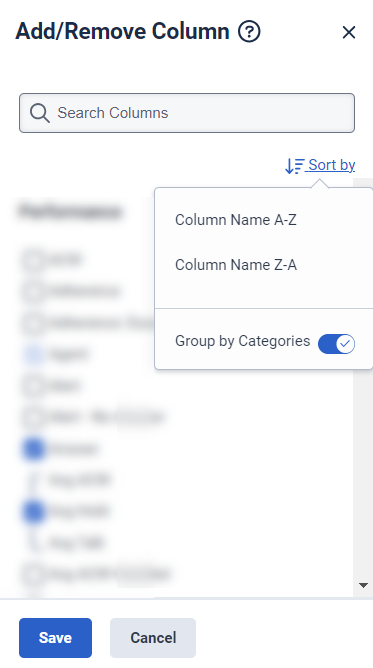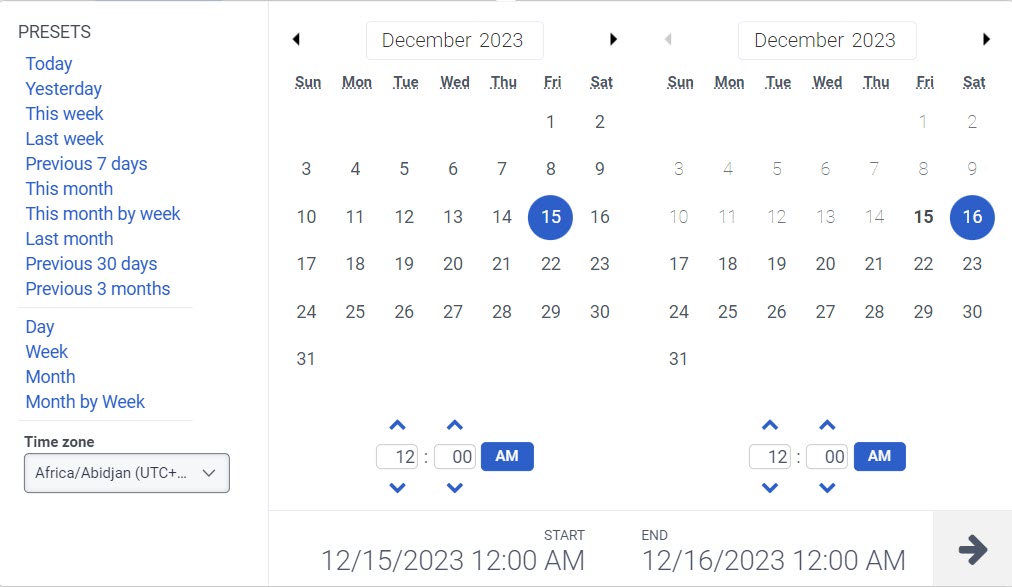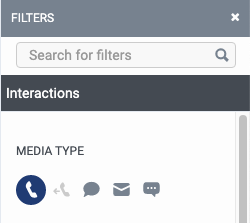Survey Performance Summary view
The Survey Summary view displays statistics for survey forms sent to customers after an interaction. Use it to find out how many surveys Genesys Cloud sent, the status of those surveys, and the results of the surveys. Each row in the view displays a survey form and its related metrics.
Available columns
To view the available columns, see Survey Performance Summary view section in the View available columns in performance views by category article.
To view the consolidated list of available columns in the performance views, see Consolidated view of available columns in performance views.
To view the list of available columns in the performance views by category, see View available columns in performance views by category.
Set a default time zone in the workspace
You can set the default time zone in the analytics workspace before viewing any analytics view.
To set the default time zone in the workspace, follow these steps:
- Click Performance > Workspace.
- On the left side, from the Time zone drop-down menu, select the required time zone as the default time zone for the analytics workspace.
To see the Survey Summary view, go to Performance > Workspace > Employee Engagement > Survey Performance.
This view does not update automatically. To see the most current data, click Refresh .
To save the view with your filter and column settings, click Save .
To export the data in the view, click Export .
Note: Genesys Cloud displays survey data in the interval when it sent the survey, not in the interval that the customer answers the survey. For example, if Genesys Cloud sends the survey on January 10, and the customer completes the survey on February 15, then the data for the survey appears on January 10.
View more details about a survey form
To see the form versions and related metrics for a survey form, click beside the survey form’s row. The form versions and their data display under the survey form’s row.
To see the survey questions and responses for that form version, click the date of the version. The Survey Detail view for that version opens.
Customize the view
Customize the view to show only certain data. For example, you can choose to show only certain columns or filter to see certain types of interactions. You can also save your filter and column settings as a saved view to quickly switch between different data of interest in the same view.
To customize analytics views, use the date filter.
To filter metrics by date or configure a custom date range, use presets. When filtering metrics for this view, select any custom date range up to 6 months.
To use a preset to filter metrics, complete the following steps:
- To display the date filter, click the date.
- In the Presets list, select a preset date option.
Date presets
| Presets | Description |
|---|---|
| Today | Shows data for the time period that includes the current interval. |
| Yesterday | Shows data for the previous day. |
| This week | Shows data for a Sunday through Saturday time period. |
| Last week | Shows data for the previous week, Sunday through Saturday. |
| Previous 7 days | Shows data for the previous seven days. |
| This month | Shows data for the current month, with no extra days. |
| This month by week | Shows data for the current calendar month starting on Sunday and ending on Saturday, including extra days if the month does not start on Sunday or end on Saturday. |
| Last month | Shows data for the previous calendar month with no extra days. |
| Previous 30 days | Shows data for the previous 30 days. |
| Previous 3 months | Shows data for the previous 3 months. For example, Nov 1, 2022 – Jan 31, 2023. |
| Day | Shows data for a single 24-hour day. |
| Week | Shows data for a Sunday through Saturday time period. |
| Month | Shows data for the exact month with no extra days. If the current month is selected, you can see the data up to the current date. |
| Month by Week | Shows data for a calendar month starting on Sunday and ending on Saturday, including extra days if the month does not start on Sunday or end on Saturday. |
To use a custom date range to filter metrics, complete the following steps:
- Click the date to display the date filter.
- Select a start date and an end date on the calendar, and click the filter arrow .
To view data for a different time period using the same date presets, click the arrows on either side of the date display. ![]()
For example, to view data for the previous day, click the Day preset, and then click the arrow on the left side of the date.
To view data for a different time zone using the same date presets, from the Time zone drop-down menu, select the required time zone. You can create and save reports with the same selected time zone.
- When filtering you can select more than one media type. Click the relevant media type to select or deselect the type.
- You cannot select the voice and callback types at the same time.
- If you select voice, the callback option will be deselected. If you select callback, the voice interaction will be deselected.
- The available media types may vary from those shown above.
The selected media type icon is displayed above the column headers. For more information about various media types and their settings, see the Set behavior and thresholds for all interaction types section in the Create and configure queues.
To show or hide columns:
- Click the Pick columns icon on the right side. The Add/Remove Column pane appears.
- (Optional) To sort the columns in ascending or alphabetical order, click Sort by > Column Name A-Z.
- (Optional) To sort the columns in descending or reverse alphabetical order, click Sort by > Column Name Z-A.
- (Optional) To categorize or uncategorize the columns, click Sort by and enable or disable the Group by Categories toggle. Click the image to enlarge.

- Search or scroll to select the columns you want to view. Note: You can also use keyboard navigation to choose the columns.
- Click Save. The selected columns appear on the screen. Note: The column selections appear only after saving the changes and do not apply to the table immediately.
To rearrange the columns, click a column header and drag it.
To reset a view to default column settings, click Reset view to defaults ![]() .
.
You can select up to 20 columns.
For more information about the metrics shown in the columns, see the Available Columns section in this article.
To enter the survey you want to view, click the Filter by survey form(s) search icon . Enter the survey name and select the survey from the search results. You can continue to enter and select additional surveys to add to the view.
Filter by selecting multiple surveys
You can select multiple surveys to filter by.
- In the survey’s row, select the check box.
- Continue selecting survey check boxes to add to filters.
- Click Add to filters.
To filter by information about the interaction, click Filters , and then search or scroll to select the filter you want to use.
Interaction filters
| Filter | Description |
|---|---|
| User |
Displays interactions associated with the selected users. Filter for multiple users at one time by entering other users and searching again. To see and select inactive users in the User filter search, select Include inactive users. |
| Queue |
Displays metrics for interactions associated with the selected queues. Filter for multiple queues at one time by entering other queues and searching again. |
| Wrap-Up |
Displays interactions that have the selected wrap-up codes. Filter for multiple wrap-up codes at one time by entering other codes and searching again. |
| Skills |
Displays metrics for interactions with agents who have the selected skills. Filter for multiple skills at one time by entering other skills and searching again. |
| Languages |
Displays metrics for interactions with agents who have the selected languages. Filter for multiple languages at one time by entering other languages and searching again. |
- Click Filters .
- Click the Surveys tab.
- Search or scroll to select the filter you want to use.
| Filter | Description |
|---|---|
| Survey Score |
Displays the surveys by scores:
|
| Survey NPS |
Displays the surveys with the selected range of NPS. For more information about NPS, see Net Promoter Score web survey question overview.
|
| Survey Type |
|
| Survey Response Status |
|



